There is an old tale of a sailor who was shipwrecked
and managed to swim through the surf to the shore, scramble over the ragged
rocks onto dry land, and then drag himself up a cliff, at the top of which he
saw a gallows. The sailor fell to his knees and thanked God that he had been
lucky enough to land in a Christian country.
Man has long applied his
imagination in devising original methods of disposing of his fellow man. A law
from the time of Æthelstan decreed,
“Let him be smitten so that his neck break.”
When Richard I was departing on crusade for the Holy Land, he
ordered that if any man were to kill another whilst aboard ship, he was to be
tied to the corpse and thrown overboard; if a man killed another on the land,
he was to be buried alive with the corpse. If a miller was found to have stolen
flour above the sum of 4d he was to be hanged from the beam of his mill. In
London, a man found guilty of treason was to be bound to a stake in the Thames
for two ebbs and two flows of the tide; ‘pirats and robbers by sea’ were
hanged at the low water mark and left ‘till three tides haue ouerwashed
them.’ In fifteenth century
Fordwich, a condemned man was bound hand and foot and thrown by the prosecutor
down the ‘Thieves Well’; at Dover, the criminal was taken to the cliff edge
called Sharpnesse and infalistationed – that is, thrown over onto the beach
below. In 1531, an Act of Parliament was passed allowing for the execution of
one Richard Rose, a cook in the kitchens of the Bishop of Rochester who had
introduced
‘…a certeyne venym or poyson into a vessel replenysshed with yeste or barme stondyng in the Kechyn,’
which had resulted in the poisoning
of at least sixteen people. On April 5th 1531, Rose was boiled to
death at Smithfield; on March 17th in the following year, Margaret
Davy, a maid-servant, was also boiled to death at Smithfield for poisoning
three households in which she had worked. There are several reports in a
variety of Chronicles that record certain individuals who called themselves
Christ were crucified for their troubles, for instance,
“A man of Oxenford faynyd hym to be Cryst, and was crucified at Addurbury.”
But of all the
methods of execution favoured in the past, hanging, drawing and quartering was
particularly popular. Regular readers of this blog will recall I have mentioned
this method in numerous posts, but let’s look at it again.
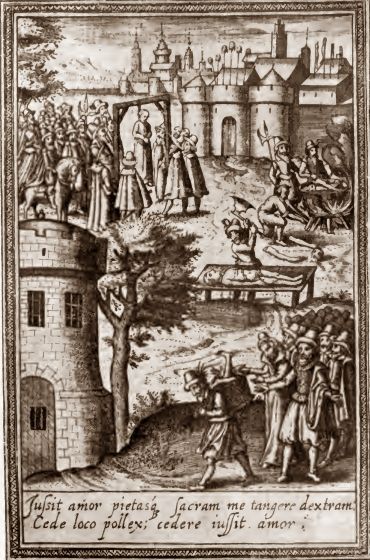 |
| Hanging and Quartering |
There is some
confusion about the terminology of this punishment, which arises from the order
in which its parts are now given. The correct order should really be drawing,
hanging and quartering, as the condemned man was first drawn – i.e. dragged –
to the place of execution; the chronicler John Capgrave writes in many places
of men being ‘hangged, drawe and qwartered’, which may be the original
cause of the confusion. There are some who think that the ‘drawing’ refers
instead to the drawing out of the criminal’s entrails but this is not the case.
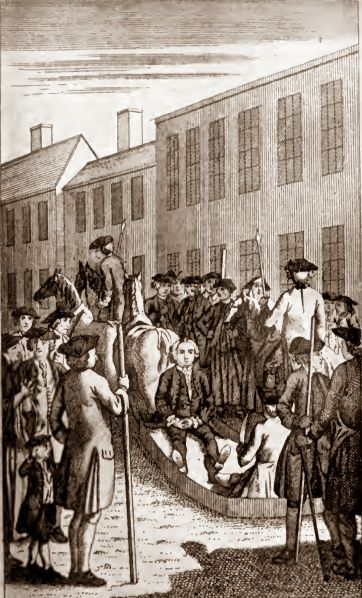 |
| Drawn to the Gallows on a sledge |
There were three types of drawing – the most common was dragging the condemned
to the gallows where he was to be hanged but in some other cases the drawing
was the actual form of execution, whereby the criminal was dragged behind a
horse until they died from the ordeal (it is well to remember the state of
roads in the past, and in some instances it is recorded that sharp stones were
sometimes placed along the route to worsen its condition). The final, rarer, type of drawing was
when a man was tied to two or more horses and pulled apart. In a dispute between
the citizens and Prior of Norwich, thirty-three rioters were sentenced to
death, some by hanging, some by burning and some specifically by drawing (equis
distracti),
“Attached to horses by the feet, they were dragged through the streets of the city till, after great suffering, they ended their lives and expired.”[Annales Monastici]
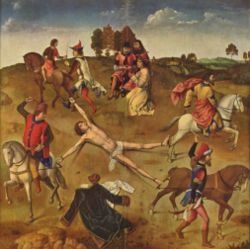 |
| Equis Distracti |
There are many,
many examples of the first sort of drawing. Sometimes, the man would have his
arms tied behind his back and would pulled along behind the horse, or would be
tied onto a hurdle or gate and dragged along, bouncing and bruising on every
rock and furrow.
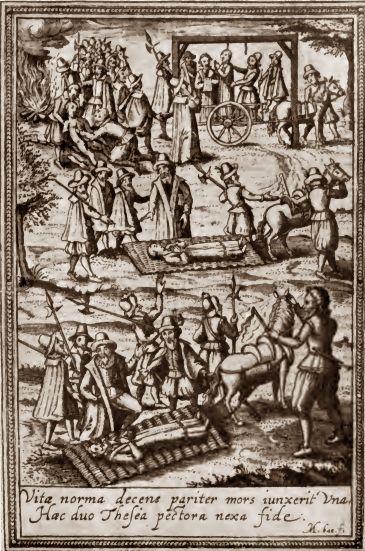 |
| Dragged to the Gallows on Hurdles |
In the case of Thomas de Turberville, sentenced for treason in
1295, it was ordered that he be drawn on a fresh ox hide, specifically to
prevent him from dying en route to the gallows. In 1238, King Henry III
ordered that a man who had crept into his bedchamber with a knife, in an
attempt to murder him, by torn apart by horses, and then beheaded with his body
being cut into three pieces, which were hung on a gibbet, the spectacle to be a
deterrent and a warning to others.
The sentence of drawing, hanging and quartering began to take the form that was followed for centuries at about this time; the prisoner would be drawn to the gallows, they would be hanged and cut down whilst still conscious, emasculated, their bowels and entails would be cut out and shown to them before being burned on a brazier, the prisoner would then be beheaded and their body cut into four pieces which would be publicly displayed.
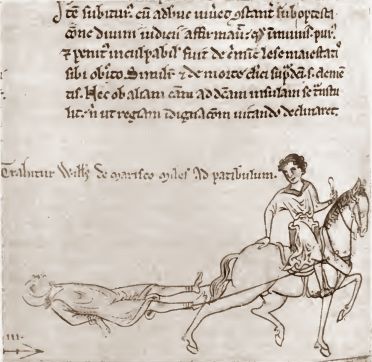 |
| Drawn behind a Horse |
The sentence of drawing, hanging and quartering began to take the form that was followed for centuries at about this time; the prisoner would be drawn to the gallows, they would be hanged and cut down whilst still conscious, emasculated, their bowels and entails would be cut out and shown to them before being burned on a brazier, the prisoner would then be beheaded and their body cut into four pieces which would be publicly displayed.
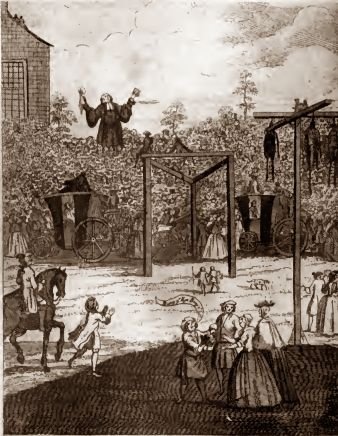 |
| Executions on Kennington Common |
In 1746, the year after the second Jacobite rebellion, nine
prisoners were killed in this manner on Kennington Common and in 1820, five men
involved in the Cato Street Conspiracy were hanged outside Newgate prison and
then beheaded by a surgeon, although they were not quartered, although the
executioners had to take refuge in the prison from an angry crowd, offended by
the spectacle. This was the last manifestation of this sort of public execution
in England.
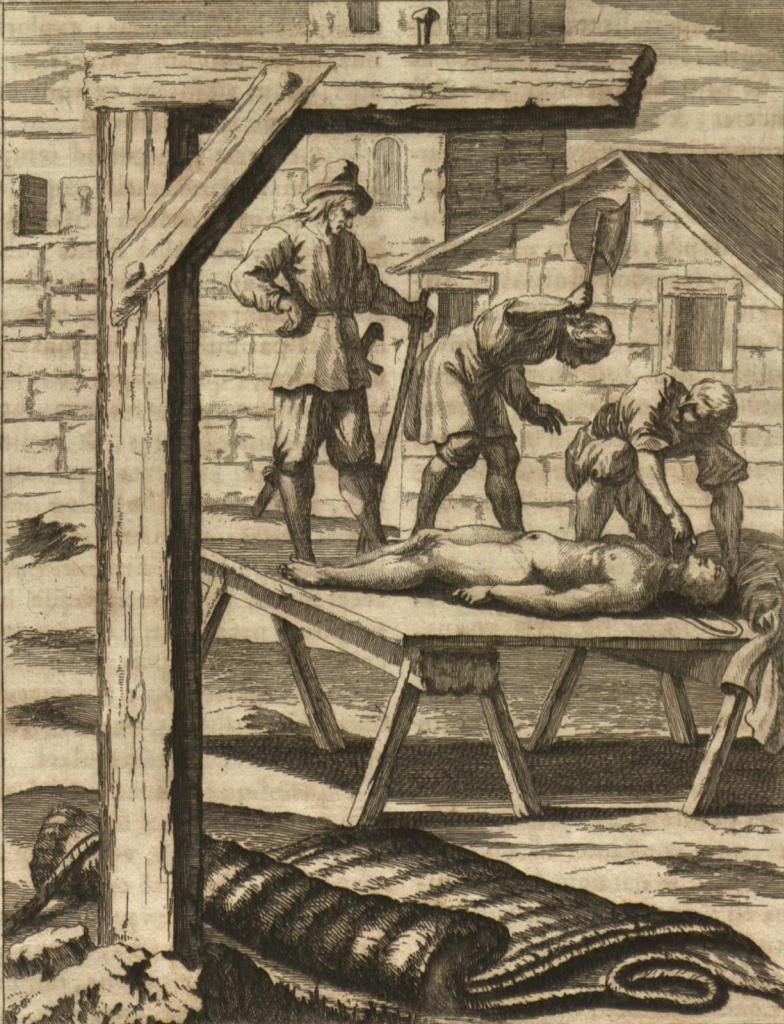
No comments:
Post a Comment